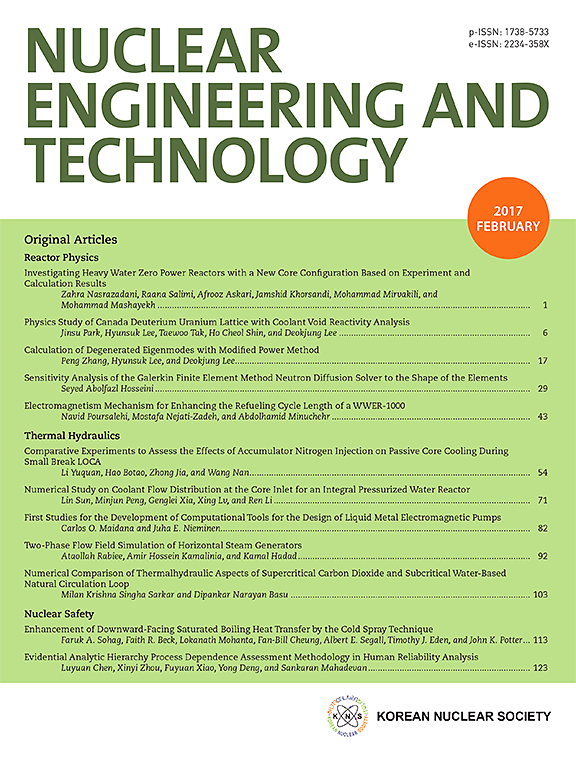建筑材料(大理石)对环境危害影响的评估,埃及东北部沙漠,Gabal El-Galala El-Bahariya
IF 2.6
3区 工程技术
Q1 NUCLEAR SCIENCE & TECHNOLOGY
引用次数: 0
摘要
加拉拉石灰石广泛用于建筑和装饰用途,在世界各地有许多商业名称,包括加拉拉白、加拉拉金、加拉拉奶油和加拉拉经典。使用 HPGe 光谱仪对大理石建筑行业的约 20 个样本进行了辐射分析,并对放射性核素 238U、232Th 和 40K 发出的伽马辐射进行了评估。测量结果显示,这些放射性核素的浓度分别为 15 ± 13、6 ± 4 和 1100 ± 330 Bq kg-1。值得注意的是,所有这些记录值均未超过国际报告的平均水平,即每种元素分别为 33、45 和 412 Bq kg-1。对年有效剂量(AED)进行了估算。年有效剂量的平均值为 0.07 毫希沃特/年,与允许的平均值 0.07 毫希沃特/年相当。利用各种多元统计技术,如皮尔逊相关性、主成分分析和层次聚类分析,研究了放射性核素与其辐射危害特征之间的关系。结果表明,造成大理石放射性危害的主要因素是铀和钾。因此,在建筑材料中使用大理石可能不会对公众健康构成重大风险。本文章由计算机程序翻译,如有差异,请以英文原文为准。
Assessment of environmental hazard impacts in building materials (Marble), Gabal El-Galala El-Bahariya, Northeastern Desert, Egypt
Galala limestone is widely used for construction and ornamental purposes and is known throughout the world under many commercial names, including Galala White, Galala Golden, Galala Creama and Galala Classic. Using a HPGe spectrometer, about 20 samples from the marble building industry were radiometrically analyzed and the gamma radiation emitted by the radionuclides 238U, 232Th and 40K was evaluated. The measurements performed showed that the concentrations of these radionuclides were 15 ± 13, 6 ± 4 and 1100 ± 330 Bq kg−1, respectively. It's important to note that all these recorded values do not exceed the internationally reported average levels of 33, 45 and 412 Bq kg−1for each individual element. The annual effective dose (AED) was estimated. The mean value of AED, 0.07 mSv/y, is comparable to the permissible average of 0.07 mSv/y, respectively. The relationship between radionuclides and their radiological hazard characteristics was studied using various multivariate statistical techniques such as Pearson correlation, principal component analysis (PCA), and hierarchical cluster analysis (HCA). The results indicate that the main contributors to the radiological hazard associated with marble are uranium and potassium. As a result, the use of marble in building materials may not pose a significant risk to public health.
求助全文
通过发布文献求助,成功后即可免费获取论文全文。
去求助
来源期刊

Nuclear Engineering and Technology
工程技术-核科学技术
CiteScore
4.80
自引率
7.40%
发文量
431
审稿时长
3.5 months
期刊介绍:
Nuclear Engineering and Technology (NET), an international journal of the Korean Nuclear Society (KNS), publishes peer-reviewed papers on original research, ideas and developments in all areas of the field of nuclear science and technology. NET bimonthly publishes original articles, reviews, and technical notes. The journal is listed in the Science Citation Index Expanded (SCIE) of Thomson Reuters.
NET covers all fields for peaceful utilization of nuclear energy and radiation as follows:
1) Reactor Physics
2) Thermal Hydraulics
3) Nuclear Safety
4) Nuclear I&C
5) Nuclear Physics, Fusion, and Laser Technology
6) Nuclear Fuel Cycle and Radioactive Waste Management
7) Nuclear Fuel and Reactor Materials
8) Radiation Application
9) Radiation Protection
10) Nuclear Structural Analysis and Plant Management & Maintenance
11) Nuclear Policy, Economics, and Human Resource Development
 求助内容:
求助内容: 应助结果提醒方式:
应助结果提醒方式:


